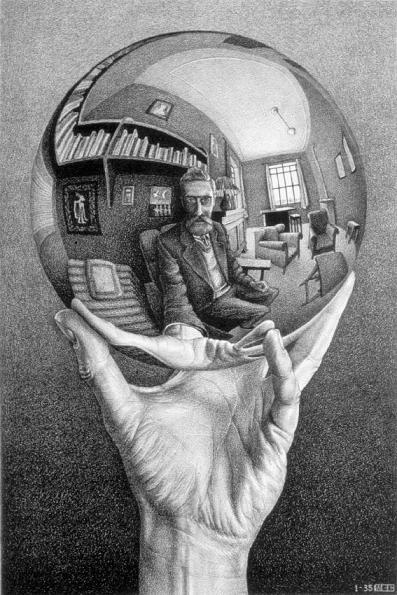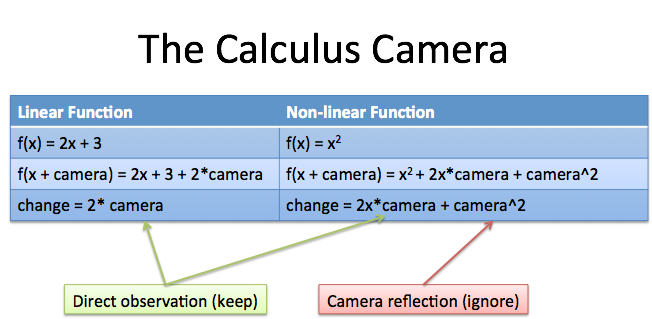Imagine you're a photographer. You come across a beautiful, reflective object: a metal sphere, a calm lake, a mirrored room. Seems like a good photo op, right?
Sure, except your photos come out like this:

(An old-timey selfie. Source.)
The dilemma: You need a camera for the photo, but don't want the camera in the photo. The instrument shouldn't appear inside the subject. (Hubert, you're leaving scalpels in the patient again.)
So, we need an isolated photo of a shiny object. What can we do?
Shrink it down: Make the camera as small as possible. Microscopic, a fleck of dust. But even that speck will show up on the sphere. Take the photo, and fix the blemish with our best guess given the surrounding pixels.
Go invisible: Make the camera unobservable to the subject: make it from perfectly transparent glass, or actively camouflage with your surroundings (like an octopus). The camera is there, looking at the subject, but the subject cannot notice it.
In Calculus, a function like f(x) = x2 is our subject. Limits (shrinking) and infinitesimals (invisibility) are how we take photos without our reflection getting in the way.
Taking a Photo of a Function
Consider a function like f(x) = 2x + 3. If I take a photo with my camera, I get:
- Before: f(x) = 2x + 3
- After: f(x + text(camera)) = 2(x + text(camera)) + 3 = 2x + 3 + 2text(camera)
We have the original function, and put the camera into the scene. The result is the original function (2x + 3) and the camera observing "2". That is, the camera thinks "2" is how much the function has changed. (And yes, frac(d)(dx) 2x + 3 = 2.)
Ok. Now take a function like f(x) = x2. Again, let's put the camera into the scene to observe changes:
- Before: f(x) = x2
- After: f(x + text(camera)) = (x + text(camera))2 = x2 + 2x · text(camera) + text(camera)2
Hrm. The camera is directly observing some changes (2x · text(camera)) but there's another text(camera)2 term: the camera is observing its own reflection! The term text(camera)2 only exists because we have a camera in the first place. It's an illusion.
What's the fix?
List all the changes the camera sees:
![\begin{align*}
f(x + \text{camera}) - f(x) &= [x^2 + 2x \cdot \text{camera} + \text{camera}^2] - [x^2] \\
&= 2x \cdot \text{camera} + \text{camera}^2
\end{align*} \begin{align*}
f(x + \text{camera}) - f(x) &= [x^2 + 2x \cdot \text{camera} + \text{camera}^2] - [x^2] \\
&= 2x \cdot \text{camera} + \text{camera}^2
\end{align*}](/wp-content/plugins/wp-latexrender/pictures/530c7426ad338e83382516df979a4dce.png)
Figure out what the camera directly observed. We divide to see what was "attached" to the camera:

Remove "reflections" where the camera saw itself:


From a technical perspective, the last step happens by shrinking the camera to zero (limits) or letting the camera be invisible (infinitesimals).
Neat, eh? We're reframing the process of finding the derivative: make a change, see what the direct effects are, remove the artifacts. The concept of "what the camera directly sees" and the camera's "reflection" help settle my mind about throwing away terms that appear to be there.
In math, we have fancy terms like linear and non-linear functions. We can think in terms of "shiny" or "dull" functions.
Linear functions are dull because they only have terms like x or constant values -- the camera can attach directly, and there's no reflection. Non-linear functions have self-interactions (like x2) which means the camera has a chance to see itself. Reflections need to be removed.
With multiple subjects [f(x), g(x)] or multiple cameras (for the x, y and z axis) we get cross terms like df · dg or dx · dy. The goal is the same: remove unnecessary self- and cross-reflections from the final result. Show what the camera directly sees.
A few related blog posts on limits:
The role of dx
Regular calculus books use dx as the camera to detect change. The goal is to introduce a change (dx), then get the difference (f(x + dx) - f(x)).
This difference (for example, 2x · dx + dx2) isolates the changes that dx is directly responsible for ("sees"). We can then divide by dx to get the change as a rate (how much we got out for how much we put in).
The concern is the same: the change dx may have reflections (dx2) that need to be removed.
Real-World Application: The Hawthorne Effect
The Hawthorne Effect is where people behave differently when being studied. The study itself is appearing in the results.
If you ask people to enter a study about their eating, exercise, reading, or sleeping habits, those behaviors will change. (Gotta look good for the camera! Where are those Greek philosophers I'd always meant to read?)
Math gives us a few suggestions:
Shrink the effect: Make the study as non-intrusive as possible (like an iPhone passively monitoring your steps). Even then, figure out how much the results are skewed and adjust for this. (You left your phone on the washing machine again, you sly dog.)
Make the observations invisible: Imagine you don't know when the study is going to start. "Sometime in the next 20 years we'll silently observe your grocery shopping habits. Sign here." Hrm. You won't change your behavior for 20 years "just in case", so you'll just be you.
Think math only applies to equations? Hah. Only if we don't internalize the underlying concept.
Happy math.
Other Posts In This Series
- A Gentle Introduction To Learning Calculus
- Understanding Calculus With A Bank Account Metaphor
- Prehistoric Calculus: Discovering Pi
- A Calculus Analogy: Integrals as Multiplication
- Calculus: Building Intuition for the Derivative
- How To Understand Derivatives: The Product, Power & Chain Rules
- How To Understand Derivatives: The Quotient Rule, Exponents, and Logarithms
- An Intuitive Introduction To Limits
- Why Do We Need Limits and Infinitesimals?
- Learning Calculus: Overcoming Our Artificial Need for Precision
- A Friendly Chat About Whether 0.999... = 1
- Analogy: The Calculus Camera
- Abstraction Practice: Calculus Graphs




Leave a Reply
37 Comments on "Analogy: The Calculus Camera"
Well done Kalid. nice analogy ,u can give readers many more calculus analogies such that for newton’s method an old man searching for his way with the help of a. stick where some person tempered with signposts ,as he comes closer he more accurate at finding destination and for Taylor series DNA analogy of cell,n anyway ,,Ur work is brilliant THANKS
Thanks! Newton’s Method & Taylor series would be a fun one too.
I did not understand the camera analogy.
I didn’t either. I think this is one of those cases where the insight is lost by stretching the analogy too far.
Thanks for the feedback, happy to clarify.
A camera is a tool used to observe an object. For certain objects (shiny metal, etc.), the tool can create its own reflection that is not part of the object itself. We don’t have an accurate image of the object, so we use special techniques to remove the reflection (such as photographing from far away with a zoom lens, removing the reflection in photoshop, etc.). Now we can get a clear picture of the object.
In calculus, “dx” is a tool used to observe how a function changes. Certain functions (non-linear ones) make it so the tool (dx) has a “reflection” inside the changes we measure. We have special techniques (limits, infinitesimals) that can remove these reflections so we can determine the actual change that happens.
Hope that helps!
That helped a lot, thanks for the explanation!
Ok, I understand the idea , but in real any shiny surface reflect the camera itself.
Nice! now take this and apply to canonical quantum mechanism problems like Schrodinger’s cat(the whole observer, observed separation issue). It surely will give you new insights.
Yep, there’s a nice overlap with physics here too. Observations changing the observed.
love your way of explaining, Kalid :)
Bernado
Thanks!
Perfect analogy, and as usual, Khalid with his challenging attitude, keeps encouraging others to add/ deduct pictures to further enhance/simplify the final intuition … great job Khalid.
Khalid brilliant camera idea made me think of linear as instant camera while non-linear as old camera that requires having the clip developed first on negative to produce the final picture, and then eliminate the negative.
By the way Khalid, I am still waiting to see your intuition regarding Hilbert Space and to those not familiar with Hilbert Space, David Colton provides a basic description of this abstract concept in less than 100 seconds on YouTube:
https://www.youtube.com/watch?v=zASzj4DkZXY
Thank you again Khalid and good luck to every one…
Jamal
Thanks Jamal! Hilbert spaces are new to me but sound fun.
I can understand your calculus if it alone is calculus, but I can not get connected between your math or calculus and real-world application. I mean I don insight clearly the way you apply it to real world application. Maybe there are something I missed.
Take a look at the reply above explaining the analogy more clearly. Hope that helps.
Yours are the only post on the Internet I look forward to. Reading your analogies restores my faith in mathematics and teaching. Rock on!
Thanks, glad you’re enjoying them!
Thanks! You are the “man”
Thanks!
Hi Khalid,
What a aha moment… Enjoyed reading your post umpteen times…..
Appreciate your quest, playful way of understanding things…. Nature
You have opened a new dimension of how to deal with math,
Math is a pure nature….
Definitely this analogy will only be perceived by those who have interest in physics….
I never loved anything the way I love your insight…….
Thanks a ton for sharing…
Appreciate it, thank you.
How interesting … “Definitely this analogy will only be perceived by those who have interest in physics”. I cannot talk for people who have a physics background because I don’t have one, but I can agree that I definitely didn’t get the analogy.
But that’s OK! Different people get things in different ways. I also teach (part time these days) and my motto is explain stuff in different ways. Analogies are powerful, but any one particular analogy is not always going to hit the mark with everyone.
Love it Kalid, thanks!
1935 is way after “Victorian era” (the year when Escher’s litograph was first printed) :)
Good catch, I’ll update :).
Kalid post has now gotten me to a feverish level where I impatiently wait to read the next post. I am strongly addicted to reading anything Kalid’s. You have convinced most that, nature itself that mathematics is trying to explain is what can pictorially and satisfactorily explain mathematics, the purest language! look at the way LIMIT and INFINITESIMAL was explained in relation to calculus.
Since 2009 I discovered this site, I have grown to love mathematics so much and even hitching to spread the message all because of one person, KALID. Welldone!
It’s awesome hearing how much you’re enjoying the site, thank you! When an article unlocks a love of learning it’s all I can ask for. Much appreciated.
From my point of view – the best insight from you Khalid thus far. Brilliant. I am taken away. This is what I mean by didactic “weapons of mass up-lifting” the spirits of those struggling to grasp the concept. Thank you!
Really glad you enjoyed it, thanks.
Great analogy. This analogy would have actually appealed to me even more as a way to understand the role of ‘delta x’ if I was new to limits and derivatives.
By the way, dx is not the same as delta x in Calculus. It should not be used in place of delta x.
For example, when you refer to dx in your article like so:
“Regular calculus books use dx as the camera to detect change”, or
“The goal is to introduce a change (dx), then get the difference (f(x+dx)−f(x).”
I assume what you meant to say was ‘delta x’, not dx!
For e.g.: f(x+dx)−f(x) doesn’t have much meaning. [f(x+delta_x)−f(x)]/delta_x is what you would apply the limit to.
Anyway, my pedantic quibbling aside, I totally get the wonderful insight you are brought to the topic.
Thanks for clarifying! Glad you liked it. I should do a separate follow-up for “dx” vs. “delta x”.
Oh my Thank you for the clarification – the dx as opposed to delta x really got me confused.
After the bit that says “What’s the fix?” I have questions about the second step. Why do you divide by camera (otherwise known as dx correct?)? Is it just to get rid of as many camera terms as you can?
Also, I’m thinking it’s all very well to say camera^2 only exists by virtue of dx and will therefore only add error to the result, but how do you define “a term that only exists by virtue of dx” mathematically… Without definition it’s arguably just a subjective science, right?
I read your other post, the one that talks about the effect of adding an electrode on the heart beat… You know, where you say that you look at how the derivative changes as dx approaches the number after 0 ( – I understand correctly, yes?)? I was wondering how this linked with this camera analogy? Do you remove the unhelpful camera terms and THEN see how d changes as dx approaches the number after 0?
Thanks, I’m finding this bunch of pages you’ve put together fascinating and actually quite exciting :)
Hi Tom, great question.
1) Yes, dx is the camera. We use it in the same way f(x + dx) vs. f(x + camera).
2) We divide to see our change on a “per dx” basis. That is, independent of how large our change was, we can compare them by. An analogy: to compare the return of two investments, we need to normalize for how long we had the money in each. Saying investment A grew 50% and investment B grew 30% isn’t useful until we know the time each took.
3) After dividing, we may be left with stray “dx” terms (dividing dx^2 by dx leaves dx). These are items that never appeared in the original function and are artifacts.
4) “the limit as dx approaches zero” is a mathematically justifiable way of throwing away these terms at the end. So the process is:
– Take your function
– Then introduce a change
– Measure the changes on a per-dx basis
– Lastly, throw away any leftover terms.
In the camera analogy we look for reflections and just ignore them, with the formal math we “Take the limit as dx goes to zero” and more formally erase them :). The end result is the same, where the fake changes are gone.
Glad you’re enjoying it! These analogies can use constant refinement, my goal is to have a few where at least one clicks.
For the past year, I have been teaching myself calculus just for fun (really). Now I have an entirely new perspective into what is actually occurring during the process of taking the derivative. Thanks, dude.
I have a quest the subject is x and its image is f(x), isn’t it?
Is there an app for that? :) I too was lost on the analogy, can you give an example of this applied to something tangible? Thanks, I love your ‘simplified’ ways to make me understand math.